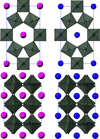issue contents
October 2019 issue

Cover illustration: 3D framework structure of europium 2-(terpyridin-4′-yl)benzenesulfonate benzene-1,2-dicarboxylate, its isomorphic lanthanide heteronuclear compounds are efficient luminescent tags, see Yi-Chen Hu et al. [(2019). Acta Cryst. B75, 855–864].
research papers
Download citation


Download citation


The polymeric structure of sodium diaquafenamate–water (1/1) is investigated and the theoretical analysis reveals that the Na—O bonds are very weak, comparable with the weak N—H⋯O intramolecular hydrogen bond. The polymeric structure is stabilized by the interaction of the sodium cation with the surrounding water molecules.
CCDC reference: 1936254
Download citation


Download citation


A photophysical study involving three biphenyl-based Knoevenagel products has been carried out. Two of the compounds show stimuli-responsive aggregation-enhanced emission. Photophysical behavior of the active fluorophore is explained based on molecular packing and π–π interactions.
The effective volumes of waters of crystallization have been determined for 27 hydrate/parent systems, with a median value of 22.8 Å3. These results may be helpful in assessing and predicting hydrate crystal structures.
Analytical description of nanowires. I. Regular cross sections for zincblende and diamond structures
Regular cross sections of zincblende- and diamond-structured nanowires (NWires) are described, and number series are presented for NWire atoms, for the bonds between these and for the NWire interface bonds for a slab of unit-cell length along the NWire axis, as well as the characteristic lengths and areas of the NWire cross sections. The ratios of internal bonds per NWire atom, of internal to interface bonds and of interface bonds per NWire atom present fundamental tools to interpret any spectroscopic data which depend on the diameter and cross-sectional shape of NWires.
Download citation


Download citation


In investigating the formation of apremilast cocrystals, this work demonstrates the preference for aromatic–aromatic interactions over hydrogen bonds in the studied crystals and the stabilizing role of disorder, leading to entropy-driven formation of the cocrystals.
Download citation


Download citation


The first powder neutron diffraction study of the hexagonal tungsten bronzes RbNbW2O9 and KNbW2O9 is presented. The existence of octahedral tilting that has not been previously observed using X-ray diffraction is also reported.
Download citation


Download citation


A new modification of CsMnPO4 (β-phase) is discussed in a superspace approach. Structural relations with topologically and chemically similar compounds are shown.
B-IncStrDB reference: 15092Eb0vgv
CCDC reference: 1937125
Download citation


Download citation


Open  access
access
 access
accessThe surface structure of fluoroapatite (0001) under dry and humid conditions has been probed with X-ray diffraction. The dry surface shows incomplete tetrahedra on the surface that are partially filled when the surface is hydrated.
Download citation


Download citation


Multi-fluorescent properties of a triphenylamine derivative are investigated under different conditions.
Download citation


Download citation


Open  access
access
 access
accessThe pathway and hybrid control mechanism of crystal nucleation were studied through both experimental and computational investigation on the role of pre-assembly and desolvation in the nucleation process.
CCDC reference: 1906930
Download citation


Download citation


Seven novel lanthanide coordination polymers were prepared. These coordination polymers exhibit several 2D and 3D framework topologies that are dictated by the choice of metal salts and carboxylate ligands. The heteronuclear compounds [EuxTb1−x(STP)(1,2-bdc)]n [STP− is 2-(2,2′:6′,2′′-terpyridin-4′-yl)benzenesulfonate and (1,2-bdc)2− is benzene-1,2-dicarboxylate] (0 ≤ x ≤ 1) have potential use as efficient luminescent tags.
An analysis of chalcogen–halogen interactions based on structures deposited in the Cambridge Structural Database is presented.
Download citation


Download citation


Using density functional theory, the structure, stability and properties of the zeta phase in the group VB transition metal carbides are examined. It is concretely shown that this phase occurs at the composition M3C2 (M = Ta, Nb, V). The three systems share a crystal structure, but they exhibit differences in how the phase accommodates non-stoichometry, which has implications for their material properties.
CCDC reference: 1946866
Download citation


Download citation


Optical properties and crystal structure of organic–inorganic hybrid perovskite [NH3CH2CH(NH3)CH3]BiCl5 (determined using single-crystal X-ray diffraction) are presented. The title compound crystallizes in the orthorhombic noncentrosymmetric space group Pca21 with eight molecules per unit cell.
CCDC reference: 1855904
Download citation


Download citation


A series of substituted 2-(N-arylimino)coumarin-3-carboxamides is divided into three groups of isotypic crystal structures with different molecular structure and crystal organization.
Download citation


Download citation


A novel compound, Rb2CaCu6(PO4)4O2, was synthesized by a hydrothermal method and characterized as the shchurovskyite-type structure, based upon a heteropolyhedral copper phosphate framework. Microscopic calculations are indicative of possible low-dimensional magnetic behavior, as they confirm weak magnetic coupling between the copper-based layers mediated by the Cu–Cu pairs.
CCDC reference: 1870440
book reviews
Free 



 journal menu
journal menu








































